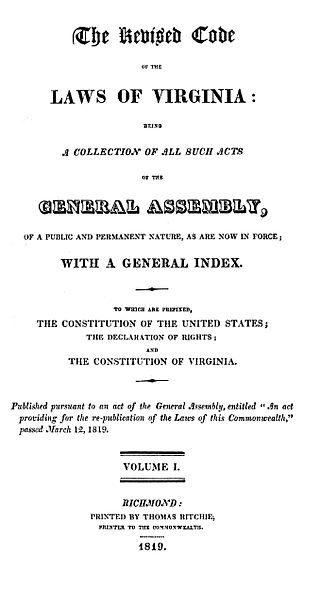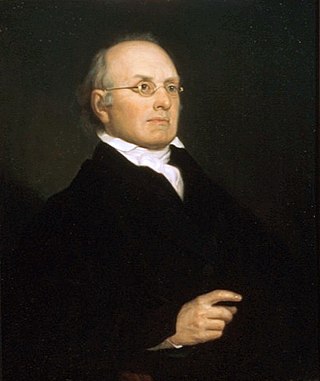Related Research Articles

In the law of the United States, the Code of Laws of the United States of America is the official compilation and codification of the general and permanent federal statutes. It contains 53 titles. The main edition is published every six years by the Office of the Law Revision Counsel of the House of Representatives, and cumulative supplements are published annually. The official version of these laws appears in the United States Statutes at Large, a chronological, uncodified compilation.
In law, codification is the process of collecting and restating the law of a jurisdiction in certain areas, usually by subject, forming a legal code, i.e. a codex (book) of law.
A repeal is the removal or reversal of a law. There are two basic types of repeal; a repeal with a re-enactment is used to replace the law with an updated, amended, or otherwise related law, or a repeal without replacement so as to abolish its provisions altogether.
The Internal Revenue Code (IRC), formally the Internal Revenue Code of 1986, is the domestic portion of federal statutory tax law in the United States, published in various volumes of the United States Statutes at Large, and separately as Title 26 of the United States Code (USC). It is organized topically, into subtitles and sections, covering income tax in the United States, payroll taxes, estate taxes, gift taxes, and excise taxes; as well as procedure and administration. The Code's implementing federal agency is the Internal Revenue Service.

The United States Statutes at Large, commonly referred to as the Statutes at Large and abbreviated Stat., are an official record of Acts of Congress and concurrent resolutions passed by the United States Congress. Each act and resolution of Congress is originally published as a slip law, which is classified as either public law or private law (Pvt.L.), and designated and numbered accordingly. At the end of a congressional session, the statutes enacted during that session are compiled into bound books, known as "session law" publications. The session law publication for U.S. Federal statutes is called the United States Statutes at Large. In that publication, the public laws and private laws are numbered and organized in chronological order. U.S. Federal statutes are published in a three-part process, consisting of slip laws, session laws, and codification.

The Office of the Law Revision Counsel of the United States House of Representatives prepares and publishes the United States Code, which is a consolidation and codification by subject matter of the general and permanent laws of the United States. The Office was created in 1974 when the provisions of Title II, sec. 205, of H.Res. 988, 93rd United States Congress, were enacted by Pub. L. 93–554, 88 Stat. 1777.
The Federal Rules of Criminal Procedure are the procedural rules that govern how federal criminal prosecutions are conducted in United States district courts and the general trial courts of the U.S. government. They are the companion to the Federal Rules of Civil Procedure. The admissibility and use of evidence in criminal proceedings is governed by the separate Federal Rules of Evidence.

The Code of Virginia is the statutory law of the U.S. state of Virginia, and consists of the codified legislation of the Virginia General Assembly. The 1950 Code of Virginia is the revision currently in force. The previous official versions were the Codes of 1819, 1849, 1887, and 1919, though other compilations had been printed privately as early as 1733, and other editions have been issued that were not designated full revisions of the code.

The Connecticut General Statutes, also called the General Statutes of Connecticut and abbreviated Conn. Gen. Stat., is a codification of the law of Connecticut. Revised to 2017, it contains all of the public acts of Connecticut and certain special acts of the public nature, the Constitution of the United States, the Amendments to the Constitution of the United States, and the Constitution of the State of Connecticut, including its 31 amendments adopted since 1965. The earliest predecessor to the currently in force codification dates to 1650.

United States Navy Regulations is the principal regulatory document of the Department of the Navy, endowed with the sanction of law, as to duty, responsibility, authority, distinctions and relationships of various officials, organizations and individuals.
Charles Pinckney James was an Associate Justice of the Supreme Court of the District of Columbia.

The Crimes Act of 1790, formally titled An Act for the Punishment of Certain Crimes Against the United States, defined some of the first federal crimes in the United States and expanded on the criminal procedure provisions of the Judiciary Act of 1789. The Crimes Act was a "comprehensive statute defining an impressive variety of federal crimes".

The Crimes Act of 1825, formally titled An Act more effectually to provide for the punishment of certain crimes against the United States, and for other purposes, was the first piece of omnibus federal criminal legislation since the Crimes Act of 1790. In general, the 1825 act provided more punishment than the 1790 act. The maximum authorized sentence of imprisonment was increased from 7 to 10 years; the maximum fine from $5,000 to $10,000. But, the punishments of stripes and pillory were not provided for.
The Judicial Code of 1911 abolished the United States circuit courts and transferred their trial jurisdiction to the U.S. district courts.
The law of Colorado consists of several levels, including constitutional, statutory, regulatory, local, and case law. The Colorado Revised Statutes form the general statutory law.
The law of Pennsylvania consists of several levels, including constitutional, statutory, regulatory and case law. The Pennsylvania Consolidated Statutes form the general statutory law.
The law of Washington consists of several levels, including constitutional, statutory, regulatory and case law, as well as local ordinances. The Revised Code of Washington forms the general statutory law.
The Illinois Compiled Statutes (ILCS) are the codified statutes of a general and permanent nature of Illinois. The compilation organizes the general Acts of Illinois into 67 chapters arranged within 9 major topic areas. The ILCS took effect in 1993, replacing the previous numbering scheme generally known as the Illinois Revised Statutes, the latest of which had been adopted in 1874 but appended by private publishers since.
The Code of the District of Columbia is the codification of the general and permanent laws relating to the District of Columbia. It was enacted and is revised by authority of the Congress of the United States.
References
- 1 2 3 Wood, Margaret (July 2, 2015). "The Revised Statutes of the United States: Predecessor to the U.S. Code". In Custodia Legis blog, Library of Congress. Retrieved 13 September 2020.
- 1 2 Charles Sumner: his complete works. With Introduction by Hon. George Frisbie Hoar. Boston, Lee and Shepard. 1900. Vol. VIII. Revision and Consolidation of the National Statutes, p.5.
- ↑ June 27, 1866, ch. 140, 14 Stat. 74. Revision and Consolidation of the Statutes. An Act to provide for the Revision and Consolidation of the Statute Laws of the United States.
- ↑ May 4, 1870, ch. 72, 16 Stat. 96. Statutes of the United States. An act to provide for the revision and consolidation of the Statutes of the United States.
- ↑ ch. 33, 18 Stat. 113
- 1 2 Burdick, William L. (March 1925). "The Revision of the Federal Statutes". American Bar Association Journal . JSTOR 25709224. Archived (PDF) from the original on September 13, 2022. Retrieved 2022-09-13.